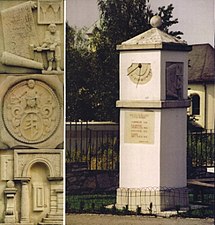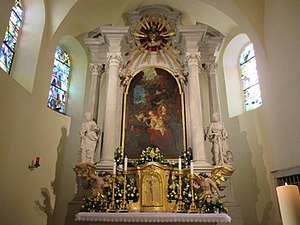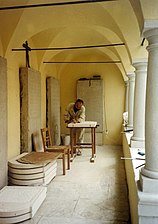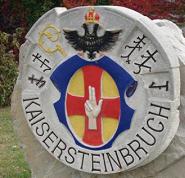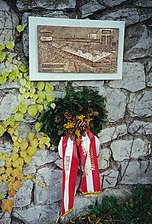Alexandru Ciutureanu
Alexandru Ciutureanu (* 1951 in Bucharest , Romania ; † March 19, 2013 ) was a Romanian sculptor . He lived and worked in his hometown to the end.
From 1990 the artist was associated with Kaisersteinbruch for over a decade through his diverse activities . His works are an important part of today's place.
Live and act
International artist symposium stone carving Kaisersteinbruch 1990
As part of the 400th anniversary of the Kaisersteinbruch , the internationally active Austrian sculptor Christoph E. Exler founded an artist symposium for stone carving in Kaisersteinbruch, Burgenland , until 1921 the Császárkőbánya was in western Hungary .
He managed to call a representative of Romania: Alexandru Ciutureanu and Hungary: Ferenc Gyurcsek to work in the once flourishing stone-cutting village on the Leithagebirge . Alexandru initially had a simple room in the inn, then the Karl and Herta Vorderdörfler family took him into their house. This marked the beginning of his warm integration in Kaisersteinbruch.
In a six-week activity, works of contemporary art are to be created from the white, very hard and dense Leitha limestone, the Kaiserstein . In a quiet meadow, this area has meanwhile been completely built up - near a filled quarry, Alexandru Ciutureanu worked on a stout, self-contained, helmeted head, chiseled with the symbols of the Trinity .
Turned away from the barracks entrance, the masterpiece rests at the village entrance. On the south side, the Cistercian cross indicated , to be reached clockwise through arched vaults. How about a mysterious way into a former spiritual center.
Kaisersteinbruch sundial pillar with Kaiserstein reliefs 1992
A stone sundial was excavated from under the root of a large tree in a garden and given to the stonemason museum. Alexandru Ciutureanu carved three emperor stone reliefs for a sundial pillar to be erected under the overall planning and stonemason work of master stonemason Friedrich Opferkuh .
- Italian masters in quarrying emperors, 1550–1720. On the scroll the names Ferrethi , Maderno , Passerini , Regondi and Della Torre . Quote from Neugebauten Castle .
- Seal of Elias Hügel , court stone mason and church builder, 1694–1755.
- Vienna Ringstrasse construction , load-bearing architectural elements , especially stairs .
Kaiserstein is processed here as a sculptural stone, if the Kaiserstein comes directly from the quarry, i.e. is still damp , it can be worked wonderfully. Lorenzo Mattielli had already got to know this quality in the facade reliefs of the city palace of Prince Eugene .
Bronze relief STALAG XVII A , 1939–1999
View of the European fountain
Radiant wreath for the high altar in 1993
For the “ God the Father in the Clouds” of the high altar , which was auctioned at Dorotheum , he designed a halo of lime wood . The 12 rays required a high level of perseverance and patience. It was not a pleasant task for a creative artist - he was won over with the splendid piece of a halo from the workshop of Giovanni Giuliani .
Way of the Cross in the Church 1994/95
14 Stations of the Way of the Cross made of cast bronze with stone frames by the sculptor Alexandru Ciutureanu, he wrote,… everything I have worked for the Kaisersteinbruch Way of the Cross is in the modeling phase in plasticine and plaster , then the bronze follows in the final phase… I'll send four photos, please a hasty answer because time doesn't wait. Received your message, I can now continue my work.
The sculptor Alexandru Ciutureanu, Romanian Orthodox Christian on his work .. I have tried to interpret the subject in such a way that it corresponds to its meaning in the Roman Catholic Church . I am fascinated by the material ( cast bronze on a stone frame) and the light . The church is circled by the sun. It is very beautiful how the rays of the sun fall on these cross-reliefs in the church. I created 47 figures in the 14 stations. These figures - I think - can tell what the Way of the Cross has to tell .
Most of the funding came from private donors , plus a subsidy from Kulturkontakt Austria .
Ortstein
Since Kaisersteinbruch has not been an independent municipality since it was merged with Bruckneudorf , it does not have its own coat of arms. In 1997, the creative artist Alexandru Ciutureanu formed a stone with symbols for the 3 names of the place from Italian stone, supported by a large, unhewn block of imperial stone.
- Heiligenkreuzer quarry: the oath hand of the Cistercians from the Heiligenkreuz Abbey , the manorial rule ("It is good to have an apartment under a crooked bar")
- Kaiser quarry: Imperial eagle - the masters only wanted to be subjects of the emperor , "emperor stone " as an honorary title and quality designation. This place name prevailed.
- Quarry on Leithaberg : stonemasons of some important masters, from left Sebastian Regondi , Elias Hügel, Johann Georg Haresleben , Johann Paul Schilck and Friedrich Opferkuh.
Years later, a color version was carried out by Ava Pelnöcker from the neighboring town of Sommerein .
European Symposium Kaisersteinbruch
In honor of the Austrian Presidency in the EU , the 1st European Symposium was celebrated on July 4, 1998, and a fountain, the Europe Fountain, was built as a visible sign. On the "ancient" (mid 17th century), very long stone wall of the former rectory, European countries will now be represented by stone reliefs. It starts with the marble relief (white marble from Ruschita ) by Alexandru Ciutureanu with an allegory of Romanian culture , a symbolism of intellectual creativity over the millennia. Figurative representations refer to precisely existing cultural assets.
literature
- Helmuth Furch : Historical Lexicon Kaisersteinbruch. 2 volumes. Museum and cultural association, Kaisersteinbruch 2002–2004. ISBN 978-3-9504555-8-8 .
Web links
- Commons : Alexandru Ciutureanu - collection of images, videos and audio files
- Helmuth Furch 1995, Kaisersteinbrucher Church Festschrift with reports on the consecration of the Way of the Cross by Bishop Paul Iby and photos of the Stations of the Cross by the sculptor Alexandru Ciutureanu.
- youtube.com , Rușchița quarry on YouTube
Individual evidence
- ^ Message from the family
- ↑ Review of the symposium leader Helmuth Furch
- ↑ Press release by sculptor Christoph E. Exler on June 24, 1990: On the recommendation of Minister Hilde Hawlicek, the Federal Ministry for Education and Art enabled this work, which touches through its strength and humanity , with a grant from the Eastern Fund .
- ↑ Ana Maria Altmann: Thoughts on the "Romania" stone of the Europe Fountain, another work of art by Alexandru Ciutureanu for Kaisersteinbruch . In Mitteilungen 53, March 1999, pp. 18f.
- ↑ January 26, 1994: Letter from Alexandru Ciutureanu to Chairman Helmuth Furch, published in Historisches Lexikon Kaisersteinbruch , pp. 497–499. ISBN 978-3-9504555-8-8 .
- ^ February 9, 1994: further letter
- ↑ March 18, 1994: further letter
- ↑ A way of the cross for Kaisersteinbruch . In the church newspaper for Burgenland, July 30, 1995.
- ^ "Wilhelm Amelin" Symposium 1997 Ortsstein, sculptor Alexandru Ciutureanu . In: Communications from the Kaisersteinbruch Museum and Culture Association , 8th year, No. 47, August 1997, pp. 31–34. ISBN 978-3-9504555-3-3 .
| personal data | |
|---|---|
| SURNAME | Ciutureanu, Alexandru |
| BRIEF DESCRIPTION | Romanian sculptor |
| DATE OF BIRTH | 1951 |
| PLACE OF BIRTH | Bucharest , Romania |
| DATE OF DEATH | March 19, 2013 |



